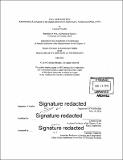| dc.contributor.advisor | Lauren Jacobi. | en_US |
| dc.contributor.author | Murphy, Caroline (Caroline Elizabeth) | en_US |
| dc.contributor.other | Massachusetts Institute of Technology. Department of Architecture. | en_US |
| dc.date.accessioned | 2017-01-12T18:32:46Z | |
| dc.date.available | 2017-01-12T18:32:46Z | |
| dc.date.copyright | 2016 | en_US |
| dc.date.issued | 2016 | en_US |
| dc.identifier.uri | http://hdl.handle.net/1721.1/106421 | |
| dc.description | Thesis: S.M., Massachusetts Institute of Technology, Department of Architecture, 2016. | en_US |
| dc.description | Cataloged from PDF version of thesis. | en_US |
| dc.description | Includes bibliographical references (pages 111-119). | en_US |
| dc.description.abstract | This thesis takes as its focus the set of illustrated plates of monastic churches and cathedrals that interleave the first volume of the Monasticon Anglicanun, a monumental Latin antiquarian tome on England's dissolved monastic establishments published in 1655. It was arranged by the antiquaries William Dugdale and Roger Dodsworth from compiled transcriptions of monastic foundation charters, and was illustrated in the early 1650s by the engraver Daniel King with over fifty full-page plates of dissolved monastic churches and cathedrals. The etcher Wenceslaus Hollar also contributed a few etchings to the project. The ambitions of this antiquarian endeavor were articulated in the publication's preface. The Monasticon was to preserve a memory of the institutional histories of monasteries, which had been dissolved and dismantled by Henry VIII's administration at the outset of the Reformation in the 1530s and 1540s, and attacked again by iconoclasts during the early years of the Civil War in the 1640s. A second objective was to record the appearances of monastic churches and cathedrals that had been converted for Protestant worship during the monastic dissolutions, and were thus among the few medieval religious structures to have weathered the iconoclastic storms largely intact. In the Monasticon, however, antiquarian desires to preserve were also underpinned by the political ambitions of its royalist, Laudian creators and benefactors to authenticate their conservative vision of the Church of England at a time when they faced persecution under Oliver Cromwell's republican regime. This thesis examines how the illustrated plates in the Monasticon's first volume depict dissolved monastic churches and cathedrals to advance and justify the aims of embattled Laudian royalists. By analyzing the graphic construction of these pictures in relation to seventeenth-century antiquarian practices and Laudian religious beliefs, these representations emerge as complex visual statements that stage monastic churches and cathedrals simultaneously as factual, historical antiquities, and also as sanctified religious spaces. Moreover, as a series of prints, these images form a collection of "paper monuments" that are recruited as artifactual evidence in support of a historical narrative that seeks to legitimize a Laudian vision of the Church, by demonstrating that it had deep roots in England's past. This thesis interrogates a set of compelling, yet overlooked antiquarian representations to open a window onto the complex and entangled meanings that were ascribed to medieval religious architecture after the Reformation, and in so doing it aligns with a growing body of scholarship that seeks to question the Weberian notion that this religious revolution heralded the "disenchantment of the world." | en_US |
| dc.description.statementofresponsibility | by Caroline Murphy. | en_US |
| dc.format.extent | 119 pages | en_US |
| dc.language.iso | eng | en_US |
| dc.publisher | Massachusetts Institute of Technology | en_US |
| dc.rights | M.I.T. theses are protected by copyright. They may be viewed from this source for any purpose, but reproduction or distribution in any format is prohibited without written permission. See provided URL for inquiries about permission. | en_US |
| dc.rights.uri | http://dspace.mit.edu/handle/1721.1/7582 | en_US |
| dc.subject | Architecture. | en_US |
| dc.title | Fact and sanctity : authenticating laudianism in the English Monasticon anglicanum's architectural prints (1655) | en_US |
| dc.title.alternative | Authenticating laudianism in the English Monasticon anglicanum's architectural prints (1655) | en_US |
| dc.type | Thesis | en_US |
| dc.description.degree | S.M. | en_US |
| dc.contributor.department | Massachusetts Institute of Technology. Department of Architecture | |
| dc.identifier.oclc | 967224247 | en_US |
